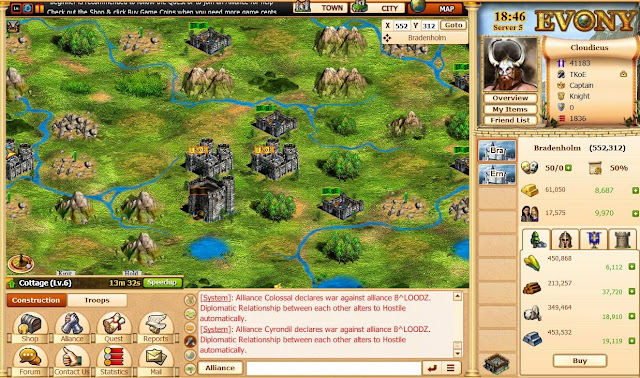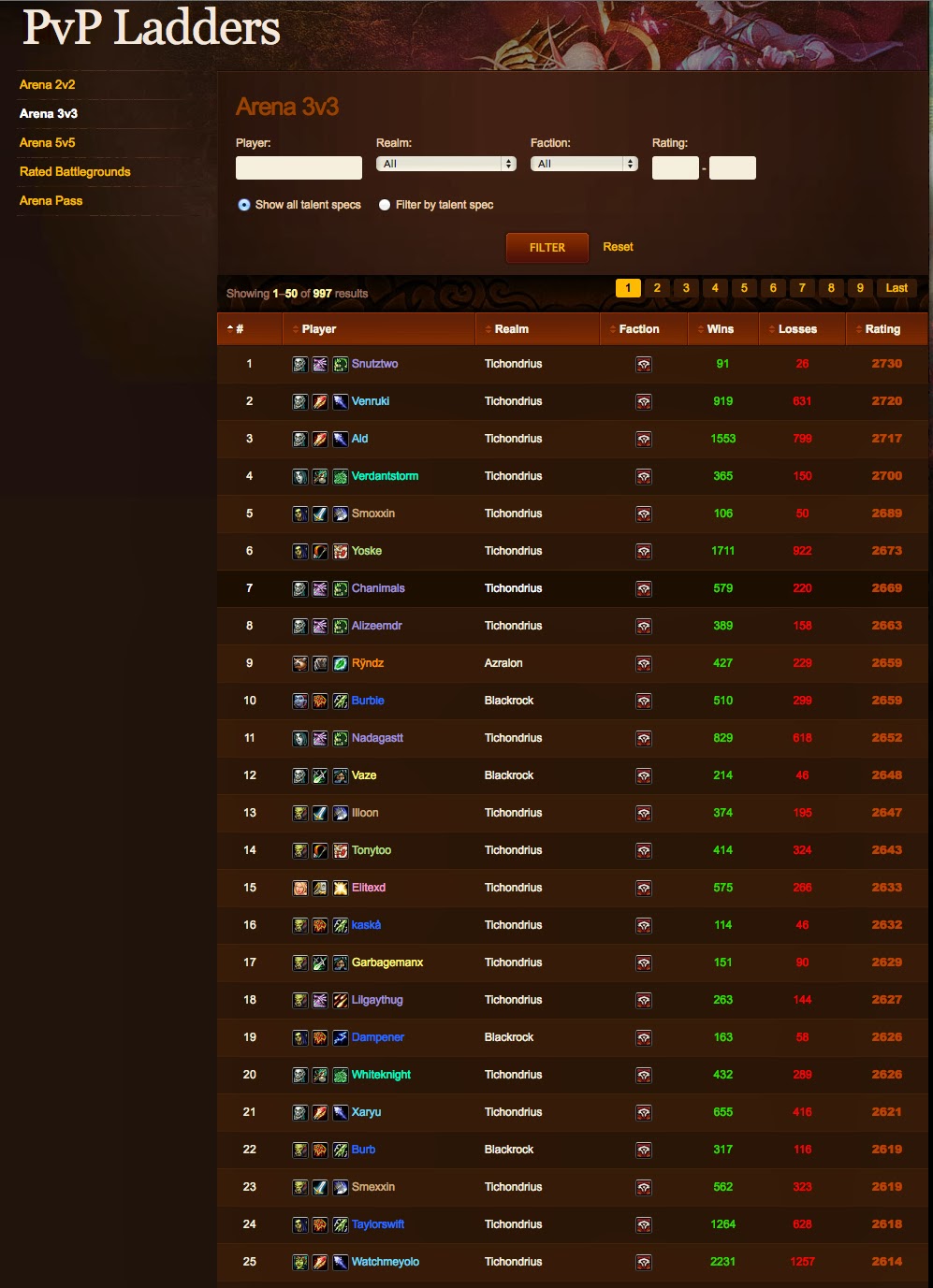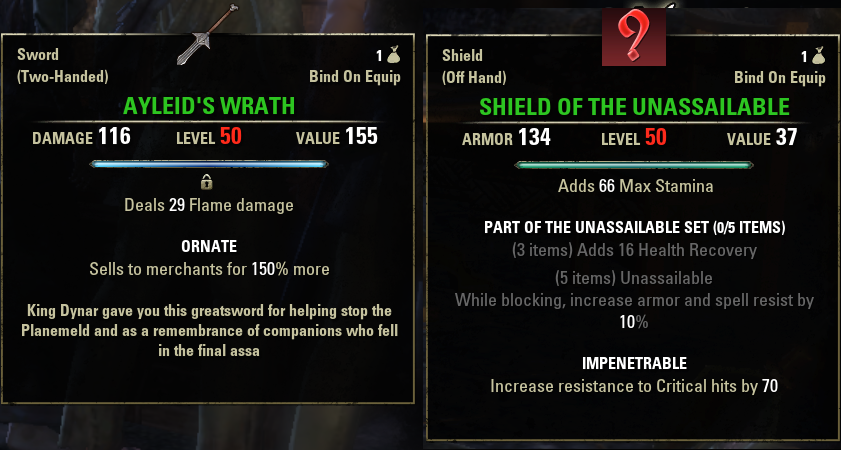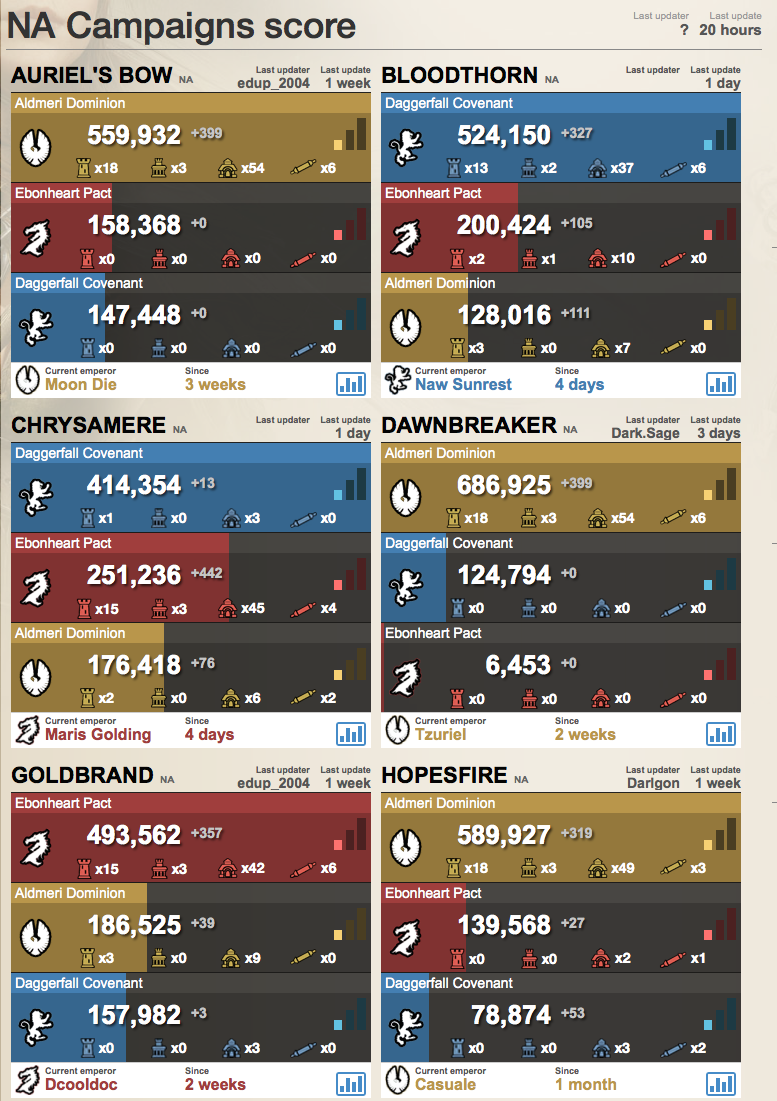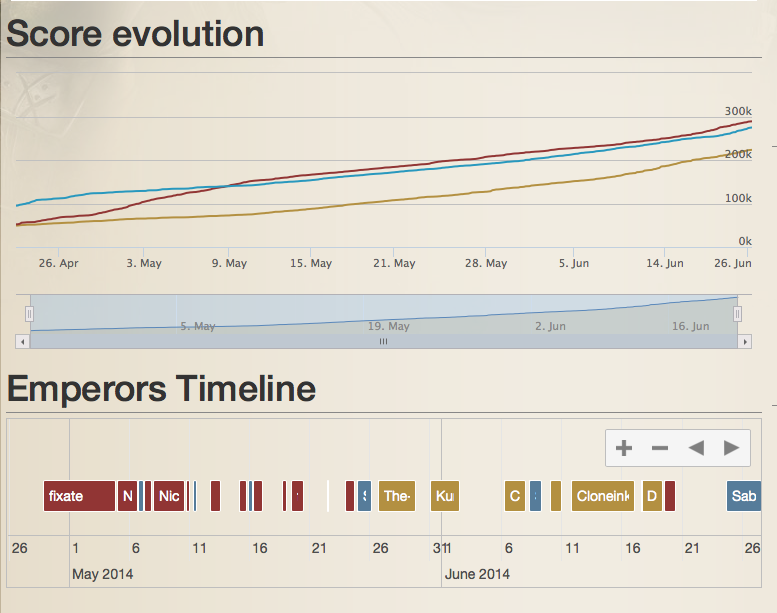This is a brief analysis of the proposed upcoming PvP changes coming to WoW in patch 5.2. My capacity to comment might be qualified by my standing as a sub-2k player (my best Arena personal rating is 1809), but here goes nonetheless. I’m going to assume that people are conversant with the proposed changes in order to keep this article brief and avoid unnecessary paraphrasing. For further details on the actual changes I would direct the reader to the Battle.net website and to read the article for themselves.
Team Rating Inflation
Implemented in order to combat high rating camping and to encourage PvP activity in the mid and later stages of the season, this change will chiefly impact higher rated players who, up to this point, have been engaging in this type of early season blitz. It won't have a significant effect on most people's playing patterns - everyone will still have to grind their CP via Arenas or Rated BGs, including high rated campers - but people pushing rating will now have to factor in inflation when deciding whether to keep on pushing or not.
The bigger implication will be how inflation redefines what current Arena ratings mean. Currently Blizzard delineates four tiers of Arena ability at 1550, 1750, 2000 and 2200 respectively by awarding achievements (and access to T2 gear at 2.2k) at each of these levels. The biggest impact Arena rating inflation will have will be to redefine what, to cite an example, a 1550 player is. A 1550 level player in Season 12 might be a 1700 player in Season 13, depending on how much team ratings increase per week. To a certain extent Arena ratings have always been elastic – the team rating has never been as important as the actual distribution curve within each of the respective Battlegroups for determining end of season titles. To cite an example, in my formative Arena days my hunter won the Challenger title (top 35% of Battlegroup) with a low 3s team rating of 1495 in Season 6, while in recent seasons a team would require a rating of at least 1600 to get the same result. In Season 13, however, there is the potential for wildly elevated team ratings depending on the rate of inflation. A mere 10 points per week over a 20 week season would add 200 points to your team rating, assuming that your team was active the whole season. This would mean that an 1800 rated player in Season 12 would become a 2k player in Season 13 (yay me!).
Elimination of the Rating Requirement for the 2.2k T2 Weapon
I feel that the rationale behind this change is a good one. Since creating a toon on Frostmourne I have had more exposure to higher level players than I am accustomed to in my home server of Thorium Brotherhood, and the chat on Skype in between Rated BG games seem to indicate widespread approval. Team captains in Rated BGs consistently scrutinize the opposition’s match making ratings to try to ascertain whether or not the opposition has access to T2 weapons. T2 represents a significant boost to the enemy’s damage output, and the removal of this demarcation line at 2.2k goes a long way to evening the playing field. Good players deserve their high standings due to their superior gameplay and coordination – they don’t need further equipment-based advantages which further distances them away from the pack, and which creates an artificial and quite unnecessary barrier between the have and the have-nots.
27000 Conquest Point Cap
To replace the 2.2k requirement Blizzard is instead implementing a 27k CP aggregate requirement to access T2 gear. 27000 divided by 1800 (the default CP cap without RBGs) equals 15 weeks of grinding – 27000 divided by 2200 (the default cap with RBGs) equals 13 weeks. To be able to get the T2 weapon in 10 weeks you would need a weekly cap of at least 2700 (actually even more because in the first week everyone has a cap of 2200). Rated BGs are going to be more important than ever in the upcoming patch, as they have a higher impact on the CP cap than Arenas. Rated BG rating will also be more important, for the same reason – players will have to try and maintain a RBG rating above 1800 in order to gain access to the T2 weapon in 10 weeks or less.
Whether or not you like this change will depend on your access to a RBG team and how good that team is. Nonetheless, the only real penalty will be time. Players who play up to the 1800 cap each week will get access to T2 gear after 15 weeks – 2200 cappers after 13 weeks – 2700 (which will require an estimated 1800+ RBG rating) cappers after 10 weeks – and even less for higher rated players with higher CP caps. A player who has the maximum possible weekly CP cap of 4000 points (I’m not sure at what rating this happens at) will get access to T2 after 7 weeks, making the difference between a Rank 1 Gladiator and Joe Noob (who is industriously capping his CP at 1800 every week) a mere two months. Compare this the old system, where players never even got access to T2 gear at all unless they got to 2200, and this is an amazingly dramatic improvement in the quality of life of sub 2.2k players.
Increased CP Cap for Latecomers
Another excellent idea because it allows entry to PvP in mid-season where normally the gear differential makes it very difficult to compete against players who have already been accummulating significant amounts of current PvP gear. The most common argument against this is that it invalidates the effort of people who start grinding CP at the beginning of the season. Why bother grinding from the start of the season, some argue, when someone can start 10 weeks later and instantly get the same amount of gear?
Upon closer inspection you can see the fallacy of this argument. First of all. they still have to earn those points via Arena matches and Rated BGs so they will have to play and win an equivalent amount of games nonetheless. They are not spared the grind - they just do it over a shorter period of time. Secondly, the retrospective 1000 CP bonus cap is still significantly less than the regular weekly CP cap. After 10 weeks of grinding to the minimum 1800 cap a player will have accumulated 18000 CP - a player who starts PvPing 10 weeks into the season will have accumulated a retrospective cap bonus of 10000 CP which is still 8000 less than the player who began grinding CP at the start of the season. Players with higher ratings and CP caps will have earned significantly more, making grinding from the start of the season still the optimal approach for accummulating PvP gear. All the retrospective cap does is to lessen the gap differential which would otherwise be near insurmountable.
Awarding CP for Rated BG Losses
Another good innovation, especially because of the way the CP cap becomes instrumental in how quickly one can get access to T2 weapons in 5.2. The biggest bottleneck in acquiring CP for casual players is finding a Rated BG team, and anything which encourages people to form teams should be welcomed. PuG RBG teams are usually smashed mercilessly due to lack of team cohesion, and consequently disband after one or two losses without anything to show for their efforts. This innovation will encourage people to persevere, as even losing efforts award CP and help them reach their weekly cap.
Preliminary Conclusions
Speaking as someone who is on the wrong side of the 2.2k divide, I have nothing but applause for all these upcoming changes. I could see how this would irk players on the other side of 2.2k, because it removes the exclusivity of that particular club of players – you either had the weapon or you didn’t, and as a further boost your weapon allowed you to deal a significantly higher level of dps than those people who could not make the 2.2k cut. Taking the rating requirement away and giving access to it to everyone else does not diminish the original achievement of getting there in the first place. It takes great team work and gameplay to get that kind of rating, and it may well be out of reach for someone like me. What I have always found objectionable, however, is giving great players a further and quite unnecessary advantage in gear. The best analogy I can come up with would be like holding a chess tournament and awarding people who achieve a high level on the ladder an extra piece to play with in subsequent games. It's not hard to imagine a scenario where two teams, one above 2.2k armed with T2 weapons and the other just below 2.2k armed with T1 weapons, being pitted together by the match maker. Assuming mirror teams (to avoid balance arguments) and equal skill, the team armed with T2 weapons would win. How can that be considered fair? The only thing the team armed with T2 did different to their counterparts was that they acquired their weapon earlier. Hence part of the reason why high level teams blitz so early in the season is to get the weapon because it gives them such a powerful edge. They are, in essence, forced to do so because failing to acquire the weapon early would disadvantage them dramatically against their counterparts. Removing the rating requirement on 2.2k weapons seems to be the logical conclusion of Blizzard's movement away from a misconceived system of PvP rewards to a much more egalitarian playing field where skill and teamwork, not gear, are primary determiners of rating.
Team Rating Inflation
Implemented in order to combat high rating camping and to encourage PvP activity in the mid and later stages of the season, this change will chiefly impact higher rated players who, up to this point, have been engaging in this type of early season blitz. It won't have a significant effect on most people's playing patterns - everyone will still have to grind their CP via Arenas or Rated BGs, including high rated campers - but people pushing rating will now have to factor in inflation when deciding whether to keep on pushing or not.
The bigger implication will be how inflation redefines what current Arena ratings mean. Currently Blizzard delineates four tiers of Arena ability at 1550, 1750, 2000 and 2200 respectively by awarding achievements (and access to T2 gear at 2.2k) at each of these levels. The biggest impact Arena rating inflation will have will be to redefine what, to cite an example, a 1550 player is. A 1550 level player in Season 12 might be a 1700 player in Season 13, depending on how much team ratings increase per week. To a certain extent Arena ratings have always been elastic – the team rating has never been as important as the actual distribution curve within each of the respective Battlegroups for determining end of season titles. To cite an example, in my formative Arena days my hunter won the Challenger title (top 35% of Battlegroup) with a low 3s team rating of 1495 in Season 6, while in recent seasons a team would require a rating of at least 1600 to get the same result. In Season 13, however, there is the potential for wildly elevated team ratings depending on the rate of inflation. A mere 10 points per week over a 20 week season would add 200 points to your team rating, assuming that your team was active the whole season. This would mean that an 1800 rated player in Season 12 would become a 2k player in Season 13 (yay me!).
Elimination of the Rating Requirement for the 2.2k T2 Weapon
I feel that the rationale behind this change is a good one. Since creating a toon on Frostmourne I have had more exposure to higher level players than I am accustomed to in my home server of Thorium Brotherhood, and the chat on Skype in between Rated BG games seem to indicate widespread approval. Team captains in Rated BGs consistently scrutinize the opposition’s match making ratings to try to ascertain whether or not the opposition has access to T2 weapons. T2 represents a significant boost to the enemy’s damage output, and the removal of this demarcation line at 2.2k goes a long way to evening the playing field. Good players deserve their high standings due to their superior gameplay and coordination – they don’t need further equipment-based advantages which further distances them away from the pack, and which creates an artificial and quite unnecessary barrier between the have and the have-nots.
27000 Conquest Point Cap
To replace the 2.2k requirement Blizzard is instead implementing a 27k CP aggregate requirement to access T2 gear. 27000 divided by 1800 (the default CP cap without RBGs) equals 15 weeks of grinding – 27000 divided by 2200 (the default cap with RBGs) equals 13 weeks. To be able to get the T2 weapon in 10 weeks you would need a weekly cap of at least 2700 (actually even more because in the first week everyone has a cap of 2200). Rated BGs are going to be more important than ever in the upcoming patch, as they have a higher impact on the CP cap than Arenas. Rated BG rating will also be more important, for the same reason – players will have to try and maintain a RBG rating above 1800 in order to gain access to the T2 weapon in 10 weeks or less.
Whether or not you like this change will depend on your access to a RBG team and how good that team is. Nonetheless, the only real penalty will be time. Players who play up to the 1800 cap each week will get access to T2 gear after 15 weeks – 2200 cappers after 13 weeks – 2700 (which will require an estimated 1800+ RBG rating) cappers after 10 weeks – and even less for higher rated players with higher CP caps. A player who has the maximum possible weekly CP cap of 4000 points (I’m not sure at what rating this happens at) will get access to T2 after 7 weeks, making the difference between a Rank 1 Gladiator and Joe Noob (who is industriously capping his CP at 1800 every week) a mere two months. Compare this the old system, where players never even got access to T2 gear at all unless they got to 2200, and this is an amazingly dramatic improvement in the quality of life of sub 2.2k players.
Increased CP Cap for Latecomers
Another excellent idea because it allows entry to PvP in mid-season where normally the gear differential makes it very difficult to compete against players who have already been accummulating significant amounts of current PvP gear. The most common argument against this is that it invalidates the effort of people who start grinding CP at the beginning of the season. Why bother grinding from the start of the season, some argue, when someone can start 10 weeks later and instantly get the same amount of gear?
Upon closer inspection you can see the fallacy of this argument. First of all. they still have to earn those points via Arena matches and Rated BGs so they will have to play and win an equivalent amount of games nonetheless. They are not spared the grind - they just do it over a shorter period of time. Secondly, the retrospective 1000 CP bonus cap is still significantly less than the regular weekly CP cap. After 10 weeks of grinding to the minimum 1800 cap a player will have accumulated 18000 CP - a player who starts PvPing 10 weeks into the season will have accumulated a retrospective cap bonus of 10000 CP which is still 8000 less than the player who began grinding CP at the start of the season. Players with higher ratings and CP caps will have earned significantly more, making grinding from the start of the season still the optimal approach for accummulating PvP gear. All the retrospective cap does is to lessen the gap differential which would otherwise be near insurmountable.
Awarding CP for Rated BG Losses
Another good innovation, especially because of the way the CP cap becomes instrumental in how quickly one can get access to T2 weapons in 5.2. The biggest bottleneck in acquiring CP for casual players is finding a Rated BG team, and anything which encourages people to form teams should be welcomed. PuG RBG teams are usually smashed mercilessly due to lack of team cohesion, and consequently disband after one or two losses without anything to show for their efforts. This innovation will encourage people to persevere, as even losing efforts award CP and help them reach their weekly cap.
Preliminary Conclusions
Speaking as someone who is on the wrong side of the 2.2k divide, I have nothing but applause for all these upcoming changes. I could see how this would irk players on the other side of 2.2k, because it removes the exclusivity of that particular club of players – you either had the weapon or you didn’t, and as a further boost your weapon allowed you to deal a significantly higher level of dps than those people who could not make the 2.2k cut. Taking the rating requirement away and giving access to it to everyone else does not diminish the original achievement of getting there in the first place. It takes great team work and gameplay to get that kind of rating, and it may well be out of reach for someone like me. What I have always found objectionable, however, is giving great players a further and quite unnecessary advantage in gear. The best analogy I can come up with would be like holding a chess tournament and awarding people who achieve a high level on the ladder an extra piece to play with in subsequent games. It's not hard to imagine a scenario where two teams, one above 2.2k armed with T2 weapons and the other just below 2.2k armed with T1 weapons, being pitted together by the match maker. Assuming mirror teams (to avoid balance arguments) and equal skill, the team armed with T2 weapons would win. How can that be considered fair? The only thing the team armed with T2 did different to their counterparts was that they acquired their weapon earlier. Hence part of the reason why high level teams blitz so early in the season is to get the weapon because it gives them such a powerful edge. They are, in essence, forced to do so because failing to acquire the weapon early would disadvantage them dramatically against their counterparts. Removing the rating requirement on 2.2k weapons seems to be the logical conclusion of Blizzard's movement away from a misconceived system of PvP rewards to a much more egalitarian playing field where skill and teamwork, not gear, are primary determiners of rating.


